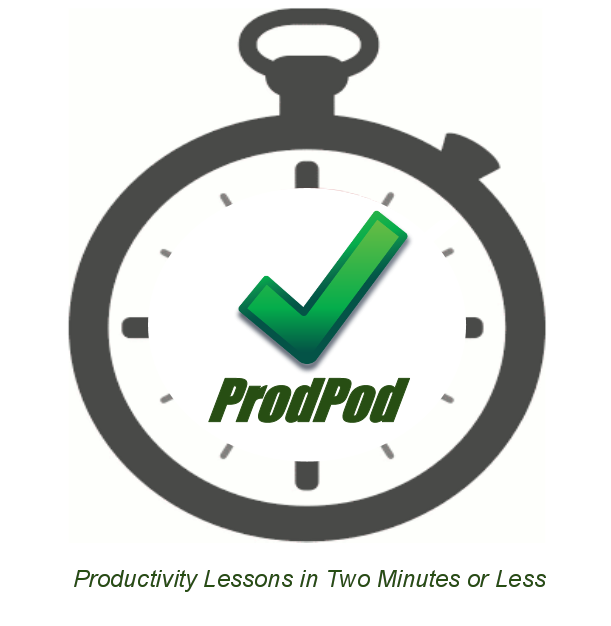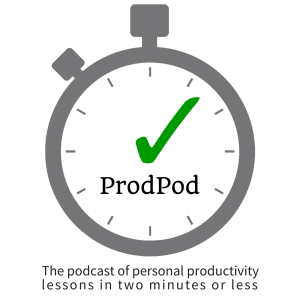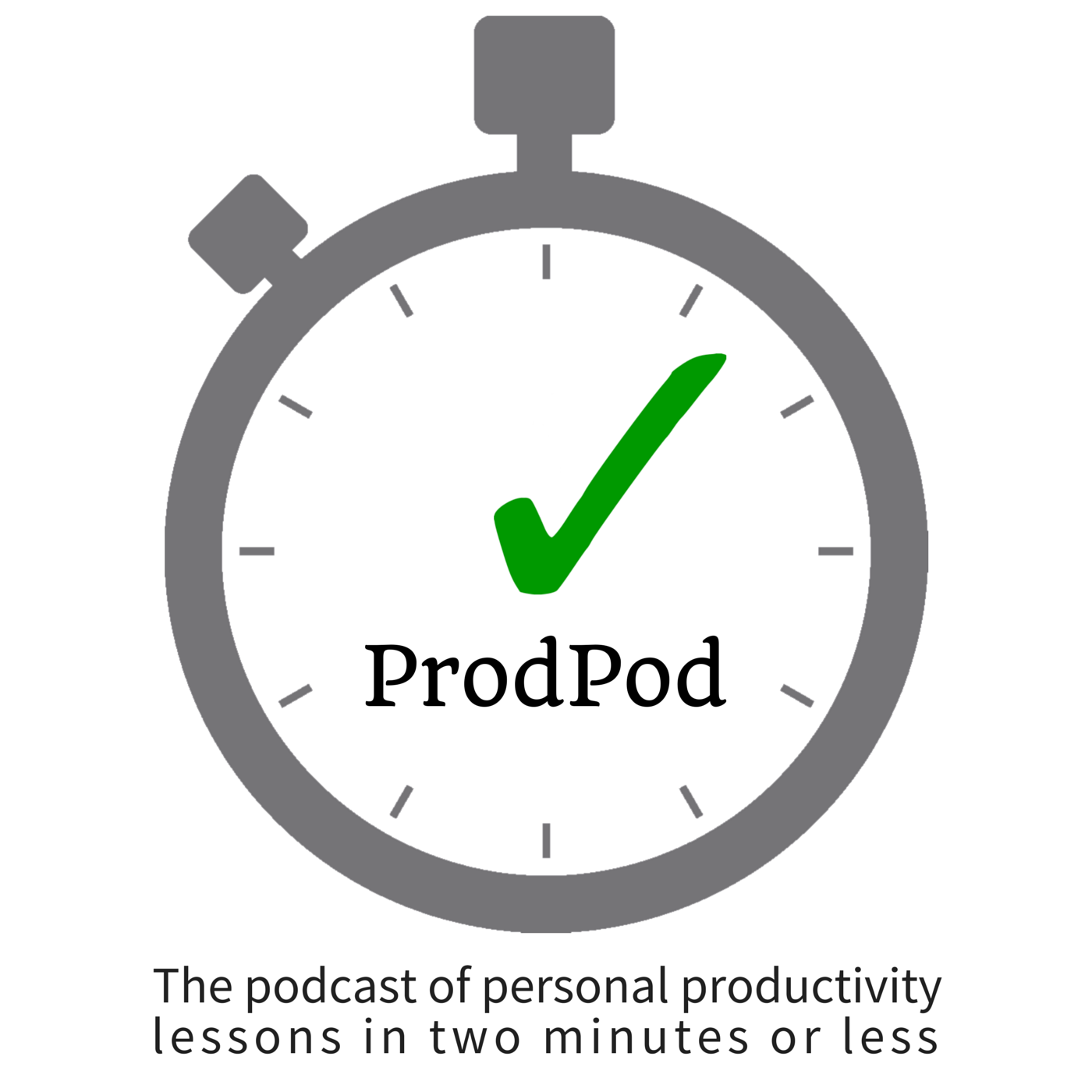Episodes

Friday Jan 10, 2014
ProdPod: Episode 81 -- Productivity and Your Two Minds
Friday Jan 10, 2014
Friday Jan 10, 2014

Tuesday Dec 24, 2013
ProdPod: Episode 80 -- Setting Up Your Workspace for Success
Tuesday Dec 24, 2013
Tuesday Dec 24, 2013
Having just finished the ProdPod series on Hoarding, I've got workspaces on the mind. And, when it comes to personal productivity, there's nothing like showing up to your home or work office workspace and seeing it set up just for you. So, in this episode, I'm going to discuss a method for making your workspace work for you every day.
Assess Your Workspace
Organization doesn't naturally happen. So, the first step is to assess your situation. Do you feel like the way things are set up in your workspace flowing well? Or, do you find there is friction when you try to access your files, when you see clutter or piles of things in particular places in your workspace, or do you trip over a coat hanger when you enter the office every day? These are the things to note that need to change to make your workspace more productive.Brainstorm and Design Your Ideal Workspace
Now that you know what needs to change, create a new project in your productivity system. Rome nor your workspace was built in a day, so you can't fix all these minor nuisances or hiccups in your productive flow in a day. Now, what do you physically need to do with each problem you noted? Do you need to call an electrician to move a light switch? Do you need to call a carpenter to put a bookshelf in just the right place for your reference books? Write down or input those actions on your written list or in your task management software or app.Create Your Workspace Rituals
In addition, I have created Morning and Midday Rituals that help me break my day into productive chunks and makes sure that I'm tidying my workspace, filtering through my RSS feed reader and then purging that inbox at least daily midday, and creating time to process my email inboxes as well as making outbound phone calls to clients, vendors, staff, colleagues and my family.
Once your physical workspace is in order, and you have the morning, midday and end-of-day rituals designed to keep your workspace in tip-top shape, you'll quickly start to reap the productive rewards of flowing effortlessly through your days. Let me know your successes and challenges by email or in the comments!

Tuesday Dec 17, 2013
Tuesday Dec 17, 2013
Ray: In this final episode of this ProdPod series on hoarding, I asked Professional Organizer Sally Reinholdt to detail how hoarding is treated and managed. Sally, take it away.
Sally: The treatment and management of severe hoarding is very complex and needs to be addressed by a comprehensive team that can include mental health professionals, professional organizers, as well as junk removal and environmental clean-up companies. From a mental health aspect, traditional talk therapy has not been found to be helpful. Dr. David Tolin [ http://www.drtolin.com ], a psychologist who has worked extensively with hoarders, uses a cognitive behavioral approach that is active and solution focused. The hoarders he works with learn to sort and let go of their possessions in conjunction with thinking through their urges to constantly acquire. Hoarders are also taken on non-acquiring trips where they learn to see and touch items without keeping them. Using these methods, the majority of Dr. Tolin’s patients show significant improvement in their levels of clutter and their feelings around the clutter. That being said, a low number of patients are considered cured. Most patients will still have more clutter than the average person and will need ongoing support to prevent backsliding.
Ray: If you're interested in Dr. Tolin's work and how it may help you, check out his fantastic book, Buried in Treasures: Help for Compulsive Acquiring, Saving, and Hoarding [ http://amzn.to/18FCpdx ]. Also, Dr. Tolin is the founder of the Institute of Living [ http://goo.gl/5sRsgK ] in Hartford, CT, so you may want to seek them out if you happen to be the greater New York metropolitan area.
Ray: Well, thanks so much for joining me on ProdPod for this series about Hoarding, Sally. If you want to learn more about Sally Reinholdt and her professional organizing services head over to her website, COSOLVA.COM [ http://www.cosolva.com ].

Tuesday Dec 10, 2013
Tuesday Dec 10, 2013
Ray: We're discussing hoarding in the ProdPod series…and I have Professional Organizer Sally Reinholdt here to define hoarding and how it's classified.
Sally: Hoarding is considered compulsive if it meets three criteria. First there is accumulation accompanied by great difficulty in discarding items that most people would consider useless or of limited value. The second criteria is that the clutter is to the point that the intended use of living spaces is severely limited or not possible. The third and last criteria is that the cluttering in combination with the acquiring and difficulty discarding causes significant impairment and distress.
Sally: The Institute for Challenging Disorganization classifies hoarding with a clutter measurement tool called the Clutter-Hoarding Scale. Homes are classified from Level I through Level V. A standard household is considered to be a Level I. Level II homes can have some narrowing of household pathways and inadequate housekeeping. Level III to Level V homes present increasingly serious situations. Clutter can be present outside as well as inside the home, there can be insect and rodent infestation and generally unsanitary conditions. Individuals working with hoarders in these types of situations need to have backgrounds ranging from but not limited to mental health and financial counseling to professional organizing, pest control and project management.
Ray: If you believe you might have hoarding issues, click on the link in the show notes here on ProdPod.net to download the Clutter-Hoarding Scale [ http://goo.gl/dy9xWf ] tool to see where you fall in the scale.
In the next episode we'll cover how hoarding is treated and managed.

Tuesday Dec 03, 2013
Tuesday Dec 03, 2013
These next three episodes will be on hoarding and I have with me to help explain hoarding, Sally Reinholdt, owner of Commonwealth Organizing Solutions [ http://cosolva.com ]. Sally is a Registered Nurse and professional organizer who uses many of the skills she learned as a nurse to help her clients become more organized and productive.
Sally: The short answer is that it can be anyone. Hoarding doesn’t discriminate. In some cases it appears to have a genetic component as hoarding can run in families. It can be the result of a traumatic experience but sometimes there is no clear trigger. Sadly, hoarders are many times very creative people who see all sorts of potential in the things they collect. Unfortunately their potential for using that creative energy is stymied by their need to constantly accumulate. There are also high levels of anxiety, depression and perfectionism associated with hoarding.
Sally: The number of hoarders in the United States is very difficult to calculate because in so many cases hoarders are able to hide their situations from family and friends until some sort of event or crisis brings the hoarding to light. Depending on the literature estimates for the number of hoarders in the United States ranges from 1.2 million to as many as 6 million people.
Sally: May, 2013, was the first time hoarding was included in the DSM-V with its own discrete clinical definition. It was previously categorized as symptom of obsessive-compulsive disorder.
Ray: Not that sweeping all your stuff under the carpet is the solution, but putting your clutter out of sight is a productivity hack in which you can reap immediate benefits. Princeton University Neuroscience Institute found that when you clear physical clutter in sight, you are less likely to be distracted and are more productive. If you're feeling distressed from physical clutter, take as much as you can and put it away so you see less of it…the more clear surfaces in sight the better. Try it. [ PUNI article, "Top-down and bottom-up mechanisms in biasing competition in the human brain": http://www.princeton.edu/~napl/pdf/BeckKastner2008.pdf ]
In Part II in this series on Hoarding, Sally and I will discuss how compulsive hoarding is defined and classified.

